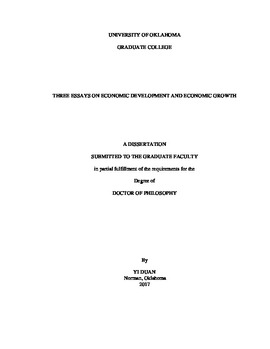| dc.description.abstract | My dissertation chapters focus on economic development and economic growth. Chapter 1 investigates the effects of bilateral FDI flows on host countries’ productivity growth as well as on the productivity gap between host countries and the frontier country - USA. Using bilateral FDI flows data from 240 countries over 1990-2012, and employing fixed effects, 2-step GMM, and instrumental variable estimation methods, the empirical results show that there is no significant effect of bilateral FDI flows on either host countries’ productivity growth or on the productivity gap between host countries and the frontier country. There tends to be no significant effects of FDI on either host countries’ productivity growth or the productivity gap between host countries and the frontier. After decomposing the effects of FDI, we find FDI tends to promote host countries’ human capital growth, but only for South-South countries. No evidence shows FDI has any impact on either labor productivity or TFP by sector.
Chapter 2 uses spatial analytical skills to investigate aid effectiveness and aid spillovers at the sub-national level in Sub-Saharan Africa over the period 1995-2013. The previous literature examines aid-growth relationship and gets mixed results. One reason of the conflicting conclusions is that it suffers from the so-called “aggregation bias”. By using geocoded aid dataset and night lights data as proxy for economic activities, I am able to reveal more detailed pictures of aid effectiveness at different aggregate levels. Overcoming the potential simultaneity problem, I find that aid targeted at the local level tends to promote local economic growth, while aid received at more aggregate levels depresses local economic activities. One possibility is that more specifically targeted aid tends to be less fungible compared to “general” aid, while aid generally given to a more aggregated level is more likely to be misappropriated for other purposes, thus creating rent-seeking opportunities to cause corruption and hurt institutional environment. There exist positive spillovers of aid effectiveness across adjacent neighbors at the local level, probably due to total factor productivity improvement, technology and knowledge dissemination, and income effect. Aid at the local level promotes total economic flourish and slows down population growth, while aid at more aggregate levels depresses total economic activities but stimulates population growth. Aid directly received at all levels exhibits diminishing returns, which is consistent with the theory that aid directly stimulates investment and adds capital accumulation. While aid spillovers show weak increasing returns, which suggests the spillover effects partly function through technology and knowledge dissemination. As to the conditional aid effectiveness, no systematic story is found that aid is effective conditional on policy or institutions, probably due to data limitations that local policy and institutions data are unavailable in Sub-Saharan Africa. The findings have very profound policy implications that to promote local economic growth, we should focus more on specifically targeted and less-fungible aid projects rather than aid generally given to governments at more aggregate levels; also we should reduce barriers to resource movements and knowledge dissemination within the country to promote positive spillover effects.
Chapter 3 uses geographic information systems (GIS) skills to test the effects of foreign aid on conflict occurrences and fatalities at local level in Sub-Saharan Africa. Using lagged aid variables as the instruments for current aid, negative relationship between current aid and future conflict is detected. Aid is effective to deter conflict when conflict events happening in short period or particular types of conflict events are under way. Income per capita, with night lights per capita as proxy, has non-linear impacts on conflict occurrences. Foreign aid can alleviate conflict and help Sub-Saharan countries to jump out of the low-income-conflict trap. | en_US |
